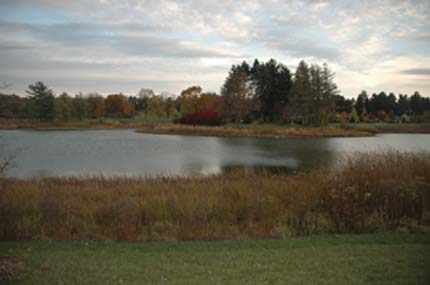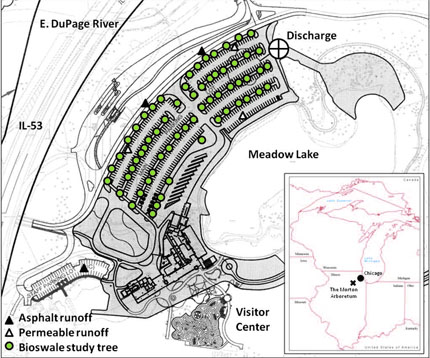Soil Science Society of America
5585 Guilford Road • Madison, WI 53711-5801 • 608-273-8080 • Fax 608-273-2021
www.soils.org
Twitter | Facebook
NEWS RELEASE
Contact: Hanna Jeske, Associate Director of Marketing and Brand Strategy, 608-268-3972, hjeske@sciencesocieties.org
Doubly green trees
October 14, 2015 - In a study published in the Journal of Environmental Quality, several tree species were the best at removing storm water from bioswales and back into the atmosphere—a process known as water cycling.
 These heroic trees were part of an upgraded parking lot and visitor center built at the Morton Arboretum, just outside Chicago. The upgrades took place in the 1990s. As an education and research facility, the team at Morton wanted to use best management practices in their design. This was especially important because the new center and parking lot would be immediately adjacent to Meadow Lake and the east branch of the DuPage River. The center wanted to avoid polluting these important waterbodies.
These heroic trees were part of an upgraded parking lot and visitor center built at the Morton Arboretum, just outside Chicago. The upgrades took place in the 1990s. As an education and research facility, the team at Morton wanted to use best management practices in their design. This was especially important because the new center and parking lot would be immediately adjacent to Meadow Lake and the east branch of the DuPage River. The center wanted to avoid polluting these important waterbodies.
Parking lots create water pollution in a few ways. By their nature, parking lots interrupt the natural flow of water into soil. Most parking lots are made of asphalt, and are impermeable. Cars naturally drip some hydrocarbons onto the pavement in the form of oil and other fluids. In northern climates (Morton Arboretum is in northern Illinois), salts must be used to keep the parking lots safe for cars and pedestrians. All these chemicals become runoff during rainstorms and snow melts, and can pollute neighboring water bodies.
Partially funded by a grant from the Illinois Environmental Protection Agency, the team designed a permeable-paver parking lot that included bioswales to clean and capture the water, and reduce the environmental effects of the parking lot and building.
Bioswales are depressions in the ground meant to capture water. Careful planning went into the placement, depth, and other features of the 1990s Morton bioswales. Loam and coarse organic matter were used in the bioswales as the best soil to support plant life and allow filtration. Plants were selected that could survive in both wet and dry conditions. Irrigation was included in the 1990 plan for times of extended drought.
Why include trees? According to Bryant Scharenbroch, corresponding author of the study, “A key component of biofilter design is the inclusion of vegetation. The vegetation helps absorb water and maybe even pollutants. Trees may be best suited to improving the biofilter performance because of their large water demand associated with their large above- and below-ground biomass.”
The study showed that the trees within the bioswales returned a lot of water back to the atmosphere. A primary way is through the leaves. The trees move water up from the roots and out through microscopic holes in the leaves, called stomata, back to the air.
 In addition to moving water into the canopy, the tree has roots that keep the soil loose and healthy. The channels created by roots also help water move down through the soil and into the groundwater system. Tree roots also help promote an active biological system of organisms functioning to store and clean water.
In addition to moving water into the canopy, the tree has roots that keep the soil loose and healthy. The channels created by roots also help water move down through the soil and into the groundwater system. Tree roots also help promote an active biological system of organisms functioning to store and clean water.
The research observed the various tree species planted in the bioswales and their performance in removing water from the bioswales. The size of the trees’ leaves, their stomata, and their ability to withstand wide variations in water levels increased their water removal performance. The bioswales seemed to benefit the trees, too, as the some tree species grew larger in them compared to non-bioswale growing environments.
The research shows that about ½ to ¾ of the total water removed from the parking lot at the Morton Arboretum was through the bioswale system. This reduced the runoff and discharge from the parking lot into the neighboring water bodies.
“Trees are very active in the water cycling of this parking lot,” says Scharenbroch. “The research clearly shows that trees are an integral part of the green infrastructure system and function to reduce runoff and discharge from the parking lot.”
The study was published in the Journal of Environmental Quality. This research was funded by The Morton Arboretum – Center for Tree Science, and a grant from the Illinois EPA.
Journal of Environmental Quality publishes original research, reviews and analyses, and environmental issue articles that address anthropogenic impacts on water, soil, and the atmosphere and pertain to some aspect of environmental quality in natural and agricultural ecosystems.